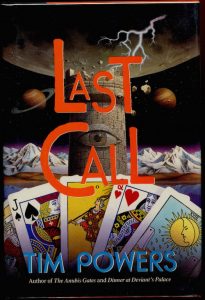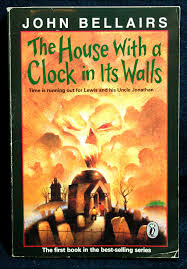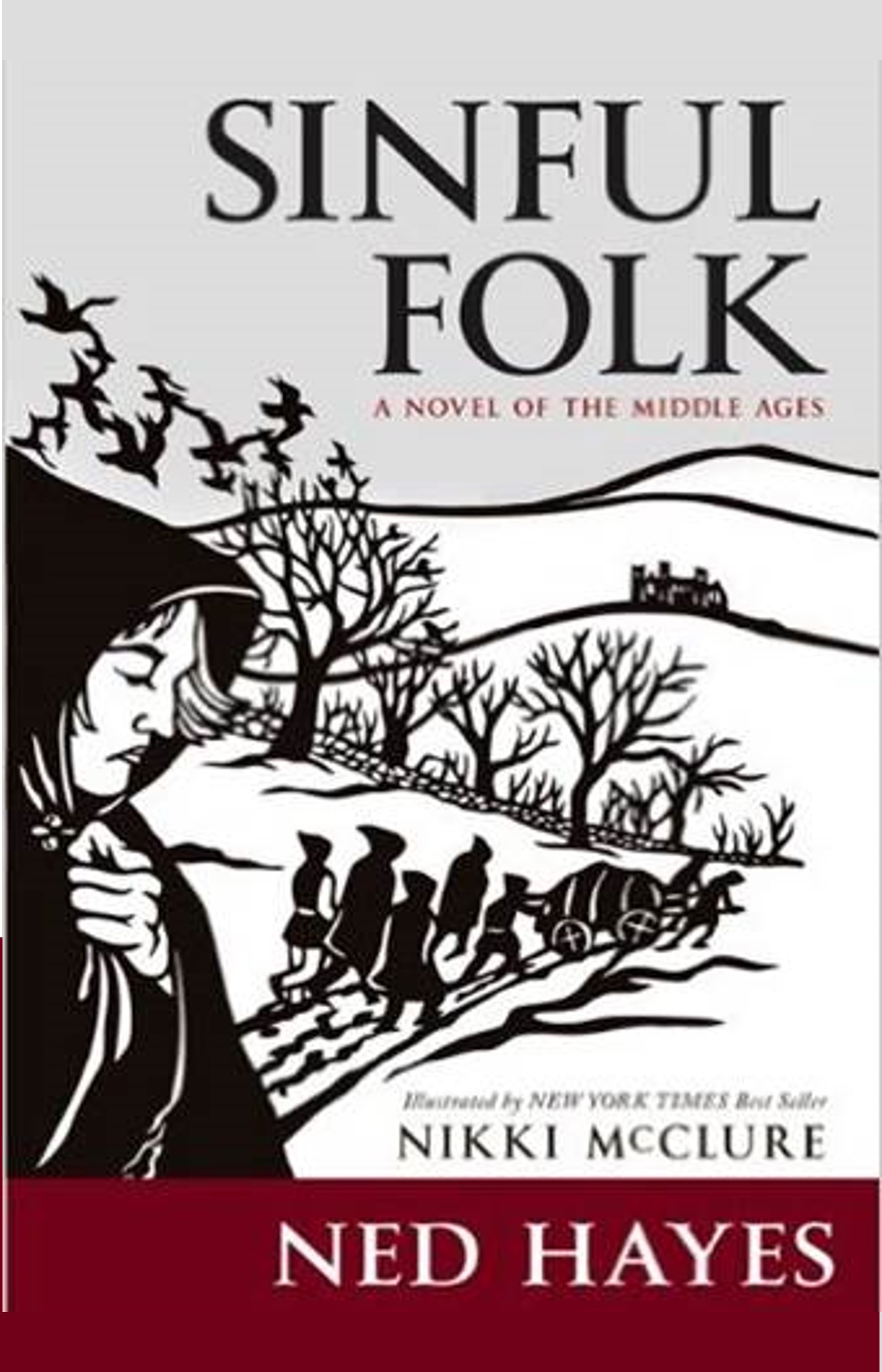LAST CALL and HOUSE WITH THE CLOCK IN ITS WALLS
Tim Powers and John Bellairs
Published on John Bellairs Birthday – January 17, 1938!
 In my spies+sorcery novel Wilderness of Mirrors, I’m trying to write a grounded fantasy that builds on known facts about the Cold War, the War on Terror, 9/11 and the WTC. I am attempting to construct a fantasy that feels as intricate and realistic as the spy novels of John Le Carré. I think I can write a pretty good spy plot, with gun battles, secrets passed in the dark, cryptographic codes to be broken, etc. The tricky part of the novel for me is writing the “fantasy” part, as to this point in my writerly life, I’ve written “straight” contemporary or historical fiction. I also have no desire to craft a world utterly divorced from our reality – a la J.K. Rowling, Tolkien or George R.R. Martin. Instead, I’d like to take the curtain that lies over some 9/11 related events, and simply lift it a little bit, to reveal the edge of “sorcery” behind the scenes. I want any “fantastic” elements to feel as if they are genuine to our reality, and could exist if only someone looked closely enough. So I am looking for models of how to do this effectively.
In my spies+sorcery novel Wilderness of Mirrors, I’m trying to write a grounded fantasy that builds on known facts about the Cold War, the War on Terror, 9/11 and the WTC. I am attempting to construct a fantasy that feels as intricate and realistic as the spy novels of John Le Carré. I think I can write a pretty good spy plot, with gun battles, secrets passed in the dark, cryptographic codes to be broken, etc. The tricky part of the novel for me is writing the “fantasy” part, as to this point in my writerly life, I’ve written “straight” contemporary or historical fiction. I also have no desire to craft a world utterly divorced from our reality – a la J.K. Rowling, Tolkien or George R.R. Martin. Instead, I’d like to take the curtain that lies over some 9/11 related events, and simply lift it a little bit, to reveal the edge of “sorcery” behind the scenes. I want any “fantastic” elements to feel as if they are genuine to our reality, and could exist if only someone looked closely enough. So I am looking for models of how to do this effectively.
 One model can be found in Tim Powers’s Last Call, a book I re-read and marked up in detail this month, specifically because I was in search of his technique of how he did magic+history in a believable way. Powers is the winner of the World Fantasy Award, and one reason that his books stand out from the general glut of fantastic fiction is that he does deep research into history, language and historical style. He also occasionally includes actual historical figures in his fantasy, but carefully written in such a way that they appear quite realistic and grounded in the period. For example, one of his historical fantasy masterworks is The Stress of Her Regard, in which Mary Shelley, Lord Byron and other poetic notables of the period are primary characters. The novel Last Call is only peripherally about the history of the gangster Bugsy Siegel and the founding of Las Vegas. Instead, it is mostly about a seemingly vagabond poker player who finds his lost step-father and has to undertake a bizarre quest back to Las Vegas, where he was abandoned as a child.
One model can be found in Tim Powers’s Last Call, a book I re-read and marked up in detail this month, specifically because I was in search of his technique of how he did magic+history in a believable way. Powers is the winner of the World Fantasy Award, and one reason that his books stand out from the general glut of fantastic fiction is that he does deep research into history, language and historical style. He also occasionally includes actual historical figures in his fantasy, but carefully written in such a way that they appear quite realistic and grounded in the period. For example, one of his historical fantasy masterworks is The Stress of Her Regard, in which Mary Shelley, Lord Byron and other poetic notables of the period are primary characters. The novel Last Call is only peripherally about the history of the gangster Bugsy Siegel and the founding of Las Vegas. Instead, it is mostly about a seemingly vagabond poker player who finds his lost step-father and has to undertake a bizarre quest back to Las Vegas, where he was abandoned as a child.
En route to Las Vegas, Scott (the vagabond), a friend, and Ozzie (the step-father) are pursued by persons unknown. They find a way to evade them, and this is where the magic enters in for the first time in the book. This is the scene I was interested in, because I found the scene very believable, but it violates every natural law I know about. I didn’t have any suspension of disbelief, because my disbelief was accounted for in the scene. Here’s the scene in a nutshell: Ozzie without much notice stops the car and asks Scott and his friend glue plastic deer whistles all over their vehicle, and put playing cards on every other surface, including the wheels. Then they have to prick their fingers and put blood spots on flags and stick the spotted flags out the window. Ozzie doesn’t even tell them what it is for, or why they are doing this. The car is a bizarre sight, and the characters share the reader’s laughter at such strange instructions.
Ozzie doesn’t explain at all what is happening, which heightens the suspense. Ozzie keeps his cards close to his chest, and instead just tells them to do these bizarre things. They follow his instructions with suspicion and hilarity (which nicely mirrors the reader’s disbelief that any of this will work). Because some of the characters share our readerly disbelief in such evident quackery, when it all does work, that fact lands on us as readers with a redoubled gravity. This makes us believe in Ozzie and in the story. Only after the scene is over, does Ozzie explain that they escaped because of these factors:
Those little plastic deer whistles [you two attached all over the car] make a complication of ultrasonic sound waves, all interfering and amplifying and damping each other, and the blood-spotted flags are a lot of organic motion… And then the main thing is the [plethora of playing] cards on the wheels, which are whizzing past the playing cards on the fenders, so…. You get a dozen new combinations of cards…. At a hasty glance, a psychic would tend to assume that there are a lot of people traveling in one vehicle (Powers 169).
As I thought more deeply about the scene, that sleight of hand in terms of withholding of knowledge really worked for me as a reader. It also was true to the sense of the story, and the concealment of fantastic elements, which is part of the plot. Why would a skilled magician or one knowledgeable in magical evasion share any of their secrets with either the reader or the other characters? If Ozzie had led with an explanation, then the “magic” of it working would have disappeared.
I experimented with re-writing the scene, and I quickly found that the best sequence was just as Powers wrote it: 1) Ozzie communicated his bizarre instructions, 2) the characters’ showed disbelief and 3) that in the end it worked, and was 4) afterwards explained later. Since Ozzie was acting in a matter of fact way in doing certain very specific activities – without explaining them – it also makes it evident that he knows precisely what he is doing (even if we don’t know), and it makes it more possible for readers to believe in his activities later on. His behavior is grounded in human reality. We don’t all go about like Hermione in Harry Potter, explaining the magic as we go along. Not explaining it makes it more magical. Withholding the explanation until later is a great plot move.
 I was also struck by a similar set of bizarre instructions that have real-world grounding in John Bellairs’s classic children’s horror novel The House with the Clock in its Walls. This scene occurs in the penultimate chapter which constitutes the “final showdown.” In this scene, the three main characters – orphan Lewis Barnavelt, Uncle Jonathan and Mrs. Zimmerman – know that they are under threat and must try to discover and battle the plans of an “evil magician.” In the hands of many writers, this scene would be formulaic. The trio would engage in detective work (either through magic or via standard deduction), and then would prepare themselves for a magical battle that would involve wands, spouts of green fire and magical creatures. (One can easily imagine a J.K. Rowling magical scene like this).
I was also struck by a similar set of bizarre instructions that have real-world grounding in John Bellairs’s classic children’s horror novel The House with the Clock in its Walls. This scene occurs in the penultimate chapter which constitutes the “final showdown.” In this scene, the three main characters – orphan Lewis Barnavelt, Uncle Jonathan and Mrs. Zimmerman – know that they are under threat and must try to discover and battle the plans of an “evil magician.” In the hands of many writers, this scene would be formulaic. The trio would engage in detective work (either through magic or via standard deduction), and then would prepare themselves for a magical battle that would involve wands, spouts of green fire and magical creatures. (One can easily imagine a J.K. Rowling magical scene like this).
However, what Bellairs does with the scene is interesting. To this point in the novel, our protagonist Lewis has established himself as a little peculiar, nerdy and unusually inventive for a 13 year old. His Uncle Jonathan is equally zany – if not more so – and is extremely disorganized. Bellairs emphasizes character over magical happenings, and makes us believe even more deeply in his world when he has Uncle Jonathan articulate how these characters have functioned throughout the novel:
We’re no good at that [logical] game. Our game is wild swoops, sudden inexplicable discovers, cloudy thinking…. Lewis, what I want you to do is this. Get a pencil and paper and dream up the silliest set of instructions you can think of. (Bellairs 158)
What follows the instructions written by Lewis is an extremely silly card game and wacky “game” that culminates in finding the “Ace of Nitwits” and the magical object that threatens them. The instructions created by Lewis is very random magic as conceived by a crazy 13 year old, and it foregrounds Lewis without giving him any special abilities. In fact, his lack of special abilities and his zany wit is what makes this chapter fun, and believable. Without Lewis being firmly established as liking these kinds of strange puzzles, the scene would never work: but with that established from chapter one, this action follows so naturally that I cannot now conceive of any other way of finishing the book. In the end, character matters more than special effects to Bellairs.
To sum up my findings on these two magical scenes, I think that two keys to writing “believable” and “grounded” fantasy that seems to be occurring in our reality are as follows: 1) Do not explain what is happening. Provide characters with specific actions that are highly specific and that they believe are “necessary” to cause the effect they want to cause. If the actions are suspect, have other characters voice that suspicion, so the reader’s perspective is embraced. Explain later, and perhaps not even then. 2) Focus on the characters and what they would naturally do. Do not insert magical behavior that does not fit the characters, their motivations, and their behavior to date.
As an addendum to my findings, I’d like to re-emphasize character. If the characters are utterly believable, and the “magic” is utterly believable to the characters themselves, it makes it easier for the reader to believe as well. Writing a fantastic scene should be an outgrowth of a character’s thought process and character development up until that point in the novel, rather than a deus ex machina that just appears or intrudes into the narrative. Writing “realistic” magic is tough, but can be done if one focuses on the basics of realistic human behavior, careful structure in scene dynamics and consistent character motivation as our guiding principles.
A literary update from NedNote.com
Readers can find my books at these bookstores:
Works Cited
Bellairs, John. The House with the Clock In Its Walls. New York: Puffin Books, 1973.
Powers, Tim. Last Call. New York: Avon Books, 1992.





